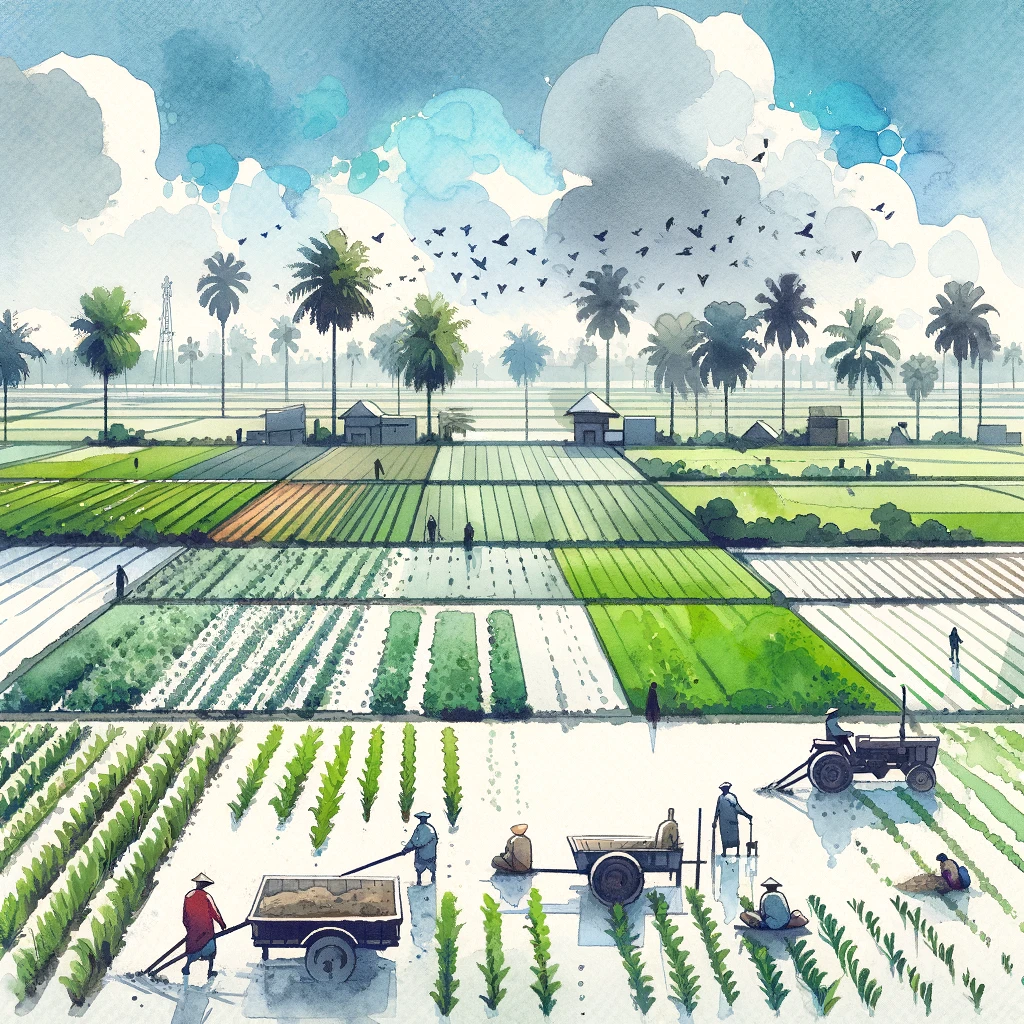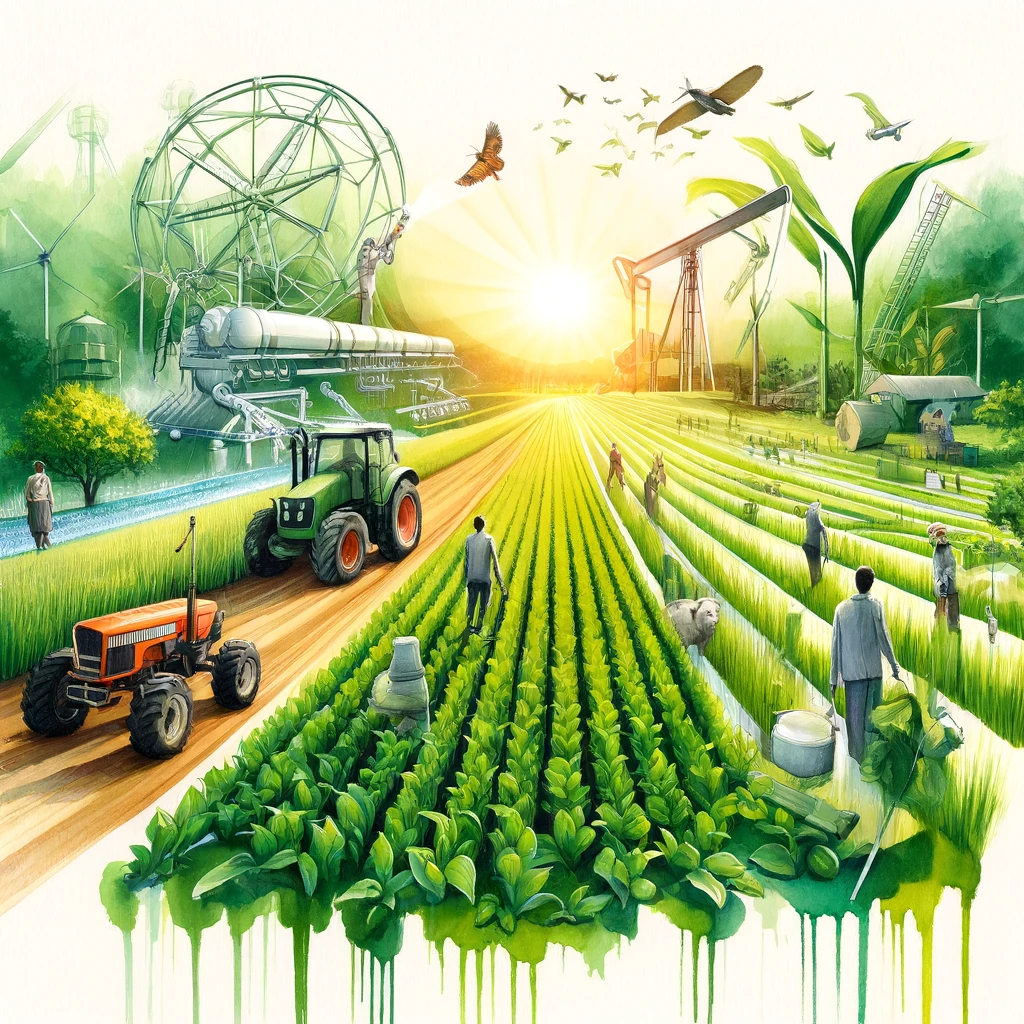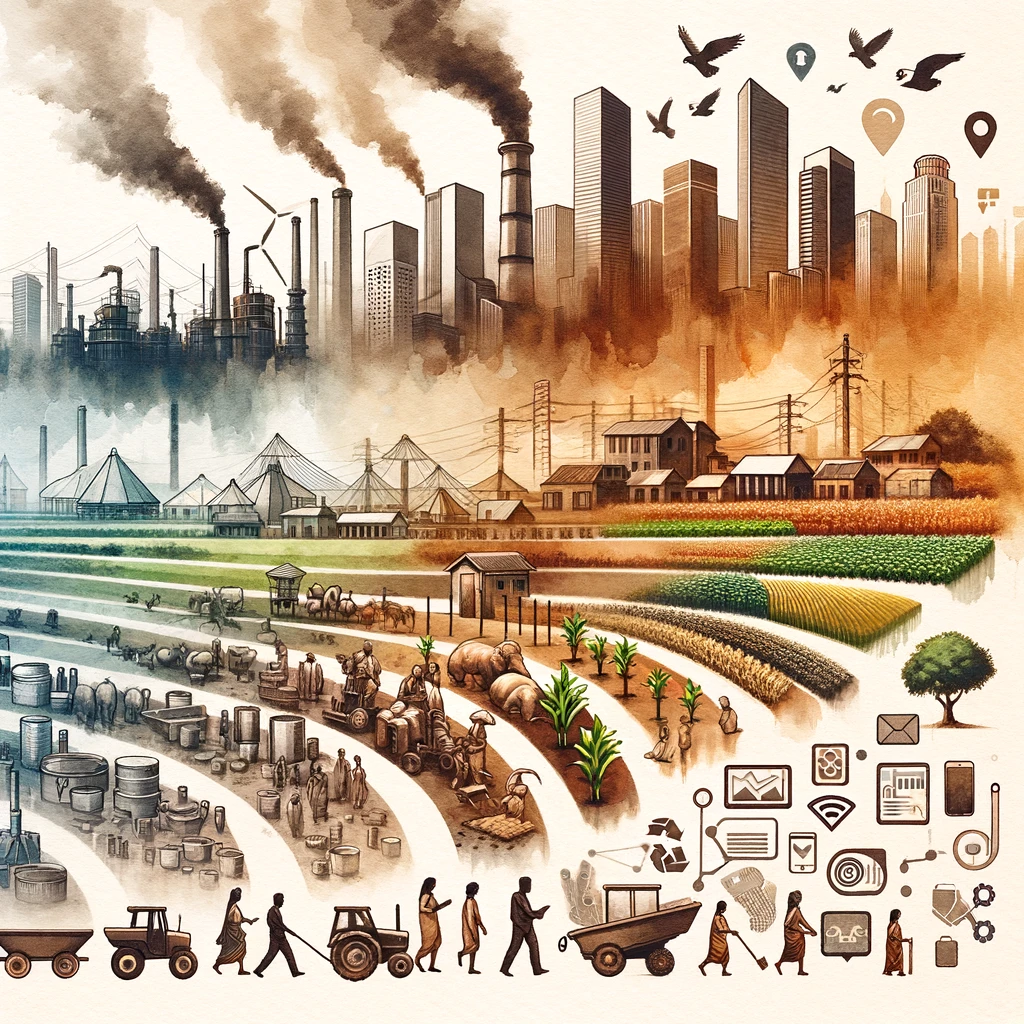Agriculture is the backbone of many economies, particularly in developing countries like India. Understanding the various types of agriculture, the factors affecting it, and the policies that support it is crucial for effective agricultural planning and management. This article delves into the nuances of agricultural geography, covering types of agriculture, influencing factors, the Green Revolution, crop patterns, and major agricultural policies.

Types of Agriculture
Subsistence vs. Commercial Agriculture
- Subsistence Agriculture: This type of farming is practiced primarily to meet the needs of the farmer’s family, with little or no surplus for sale. It is prevalent in developing countries and involves small-scale farming, traditional methods, and low productivity.
- Commercial Agriculture: This type is aimed at producing crops for sale in the market. It involves large-scale farming, the use of modern techniques, high-yielding varieties, and significant capital investment. Examples include wheat farming in the USA and tea plantations in India.
Intensive vs. Extensive Farming
- Intensive Farming: Characterized by high input of labor, fertilizers, and capital on a small land area to achieve high productivity. Examples include horticulture and dairy farming.
- Extensive Farming: Involves low input of labor and capital on a large land area, leading to lower yields per hectare but large total output. Examples include wheat farming in Canada and sheep ranching in Australia.
Plantation Agriculture
- Plantation agriculture involves large-scale, single-crop farming aimed at the export market. It is capital-intensive and uses modern techniques. Common plantation crops include tea, coffee, rubber, and palm oil. Plantations are typically found in tropical regions like India, Sri Lanka, and Malaysia.
Mixed Farming
- Mixed farming integrates crop cultivation with livestock farming. This system diversifies income sources and enhances sustainability by utilizing crop residues for animal feed and manure for fertilizing crops. It is common in Europe and parts of India.
Organic Farming
- Organic farming avoids synthetic chemicals, relying on natural processes and inputs to maintain soil fertility and control pests. It emphasizes sustainable and environmentally friendly practices. Organic farming is gaining popularity globally, including in India, due to increasing health and environmental awareness.
Factors Affecting Agriculture
Physical Factors
- Climate: Temperature, rainfall, and humidity are crucial in determining the types of crops grown in a region. For instance, rice requires high temperatures and abundant water, whereas wheat thrives in cooler, drier conditions.
- Soil: Soil fertility, texture, and depth influence agricultural productivity. Alluvial soils in the Indo-Gangetic plains are highly fertile and suitable for diverse crops.
- Topography: Flat and gently rolling landscapes are ideal for farming, while steep slopes pose challenges. Terracing is used in hilly areas to make agriculture feasible.
Economic Factors
- Market: Proximity to markets affects the profitability of agricultural produce. Farmers near urban centers have better access to markets, leading to higher income.
- Transport: Efficient transportation networks reduce the cost of moving goods, making it easier for farmers to sell their produce.
- Technology: The adoption of modern technology, such as tractors, irrigation systems, and high-yielding seed varieties, boosts productivity and efficiency.
Social Factors
- Land Ownership: Secure land tenure encourages farmers to invest in their land, leading to higher productivity. Fragmented landholdings, however, can hinder agricultural efficiency.
- Labor: Availability of labor influences the type of agriculture practiced. Intensive farming requires more labor, whereas extensive farming relies less on manual labor.
Green Revolution
Introduction and Spread
- The Green Revolution in India began in the 1960s, introducing high-yielding varieties (HYVs) of wheat and rice, along with modern agricultural techniques such as irrigation, chemical fertilizers, and pesticides.
Impact
- Benefits: The Green Revolution led to a substantial increase in food grain production, making India self-sufficient in staple crops like wheat and rice. It also contributed to rural employment and poverty reduction.
- Criticisms: Despite its success, the Green Revolution had several drawbacks, including environmental degradation due to excessive use of chemicals, depletion of water resources, and increased inequality as small farmers often could not afford the new technologies.
Lessons for Sustainable Agriculture
- Sustainable agriculture practices, such as integrated pest management, crop rotation, organic farming, and the use of renewable resources, are essential to address the environmental and social issues arising from the Green Revolution.
Crop Patterns and Major Crops
Cropping Patterns in India
- Kharif Crops: Sown in the monsoon season (June-September) and harvested in autumn. Major kharif crops include rice, maize, and cotton.
- Rabi Crops: Sown in winter (October-December) and harvested in spring. Major rabi crops include wheat, barley, and mustard.
- Zaid Crops: Grown in the short season between rabi and kharif (March-June). Examples include watermelon, cucumber, and fodder crops.
Major Food Crops
- Rice: Grown mainly in the eastern and southern states like West Bengal, Andhra Pradesh, and Tamil Nadu. It requires high rainfall and temperatures.
- Wheat: Predominantly grown in the northern states like Punjab, Haryana, and Uttar Pradesh. It thrives in cool, dry conditions.
- Maize: Grown in states like Karnataka, Madhya Pradesh, and Bihar. It is a versatile crop used for food, fodder, and industrial purposes.
Major Cash Crops
- Cotton: Grown in states like Gujarat, Maharashtra, and Telangana. It requires a warm climate and well-drained soil.
- Sugarcane: Predominantly grown in Uttar Pradesh, Maharashtra, and Karnataka. It needs a tropical or subtropical climate.
- Tea: Grown in the hilly regions of Assam, West Bengal, and Kerala. It requires well-distributed rainfall and cooler temperatures.
- Coffee: Primarily grown in Karnataka, Kerala, and Tamil Nadu. It thrives in well-drained, fertile soils and moderate temperatures.
Agricultural Policies
Minimum Support Price (MSP)
- The MSP is a government-set price at which it buys crops from farmers, ensuring them a guaranteed price for their produce. This policy aims to protect farmers from price fluctuations and provide them with a stable income.
Subsidies
- The government provides various subsidies on inputs like fertilizers, seeds, and electricity to reduce the cost of cultivation and increase farmers’ profitability.
Crop Insurance Schemes
- Pradhan Mantri Fasal Bima Yojana (PMFBY): This scheme aims to provide comprehensive insurance coverage to farmers against crop failure due to natural calamities, pests, and diseases. It ensures financial support and encourages farmers to adopt modern agricultural practices.
Initiatives for Sustainable Agriculture
- Soil Health Card Scheme: Provides farmers with information on the nutrient status of their soil and recommendations for appropriate dosages of fertilizers.
- Paramparagat Krishi Vikas Yojana (PKVY): Promotes organic farming through cluster-based programs, providing financial assistance and technical support to farmers.
Conclusion
Agricultural geography encompasses various aspects that are vital for understanding and improving agricultural practices. From the types of agriculture and factors affecting it to the impacts of the Green Revolution and crop patterns, each element plays a significant role in shaping the agricultural landscape. Government policies, such as MSP, subsidies, and crop insurance schemes, are essential tools for supporting farmers and ensuring sustainable agricultural development. Understanding these components is crucial for effective policy-making and planning in the agricultural sector.



